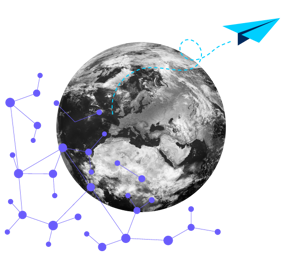- The CBI chevron_right
- Time to accelerate to net zero
Time to accelerate to net zero
As COP26 approaches, it’s clear we need to speed up on the road to net zero, says Asesoria Group’s Nick Murry.
The world is not on track to prevent dangerous climate change. Greenhouse gas (GHG) concentrations, currently at their highest levels in 3 million years, continue to rise. According to the IPCC, we will likely exceed 1.5 degrees of warming in the early 2030s and are heading for 3-4°C or higher by 2100 - 2.7 degrees even if every country fulfilled its obligations under the Paris Agreement - with potentially devastating consequences for our economy and society. The stakes could not be higher.
Yet, it is evident that many of us are living in what psychologists call a state of ‘cognitive dissonance’ when it comes to the climate crisis. We accept that climate change is happening as a result of our activities, whilst continuing to act without any real urgency; somehow avoiding reconciling the opposing versions of reality.
Businesses are no different. Most companies have long since acknowledged that there is an impending climate crisis, pledged to take action and generally succeeded in cutting some emissions. But then continued to compete and expand in ways that wipe out much, if not all the gain.
Psychologists tell us that this inconsistent state of affairs creates a dilemma, which can only be resolved if one of the beliefs is altered. With the causes of climate change irrefutable and the need for action undeniable, there can ultimately only be one outcome that relieves this tension – and that involves radically cutting emissions in line with the science.
So are businesses ready to make the leap?
There are certainly signs that things are changing. Already, over 20% of the world’s largest public companies, with annual sales of nearly $14trn, have announced commitments to net zero. The majority of these have interim targets, plans and reporting mechanisms to back them up. Here in the UK, a third of our largest businesses had signed up to the UN’s Race to Zero campaign by March this year, with more having done so since.
However, acknowledging ‘an addiction to carbon’ and pledging to give it up, doesn’t make it happen, as the Paris Agreement (with its unfulfilled pledges) has amply demonstrated. Many businesses continue to delay action and investment, perhaps waiting for regulation to ‘level the playing field’ or market forces to ease their transition. But as we approach COP26, it’s clearer than ever that we cannot put off taking serious action any longer. We all need to move much faster.
How to take meaningful action
Genuine action to get to net zero requires both company-wide and value-chain GHG reductions in line with limiting warming to 1.5 degrees, only using offsets as a temporary measure or for genuinely unavoidable emissions. Following the science-based targets approach includes cutting 95% of Scope 1 and 2, and the majority of Scope 3, where these are a significant proportion of overall emissions, without any use of offsets.
Committing to net zero needs to be backed up by a strategy with near-term and long-term targets, including milestones, transparent reporting and fully funded measures that will reduce emissions in line with the science.
In pursuing this, it is worth considering the University of Cambridge Institute for Sustainability Leadership’s four core components deemed essential for any business to be aligned with net zero:
- Align organisational purpose, strategy and business models;
- Set business goals and evidence-based targets, measure and report progress;
- Embed net zero practices in operations and value chains;
- Engage, collaborate and advocate for change across regions, sectors and markets.
The good news is that rapid decarbonisation is possible; the solutions already exist and there is plenty of support available to help businesses implement them. And once committed, companies often realise more benefit than expected in terms of reduced costs, risk and new opportunities.
The cost of inaction
Returning to my original theme; organisations cannot indefinitely hold two opposing positions – accepting the need for a net zero future, whilst maintaining ‘business as usual’ (albeit with incremental decarbonisation). It’s time to resolve the dilemma. It will require renewed commitment, investment and innovation (and potentially some short term ‘pain’) but the longer it’s left, the harder it will get and the more costly it will be.
The message is clear - embrace the challenge, make use of available expertise and find ways to cut emissions as soon as possible. Or we will all be out of business in the long run.


